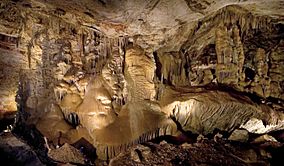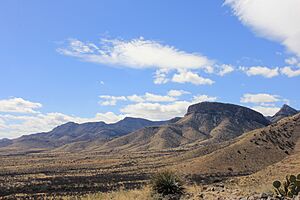Kartchner Caverns State Park facts for kids
Quick facts for kids Kartchner Caverns State Park |
|
|---|---|

The Big Room of Kartchner Caverns
|
|
| Location | Arizona, United States |
| Elevation | 4,734 ft (1,443 m) |
| Established | 1988 |
| Governing body | Arizona State Parks |
Kartchner Caverns State Park is a special state park in Arizona, United States. It's famous for its amazing show cave system. This underground world has about 2.4 miles (3.9 km) of passages to explore.
The park is located about 9 miles (14 km) south of a town called Benson. It's also west of the San Pedro River. For a long time, these incredible caverns were a secret. They were discovered in 1974 by two local cave explorers. A state biologist also helped make sure the caves would be protected.
The caverns are carved out of limestone rock. Inside, you'll find spectacular speleothems, which are unique cave formations. These formations have been growing for over 50,000 years and are still slowly getting bigger! The park uses very careful methods to protect and maintain this delicate cave system.
Contents
Discovering Kartchner Caverns
The caverns were found in 1974 by two cavers, Gary Tenen and Randy Tufts. They found a small crack at the bottom of a sinkhole. They felt warm, moist air coming from it. This led them to discover more than 2.5 miles (4.0 km) of untouched cave passages.
Randy Tufts, who later became a geologist for NASA, loved exploring caves. When he was young, he saw caves that had been damaged by people. He decided he wanted to find a cave that no one had ever harmed and protect it. For years, Randy and his friends searched the Whetstone Mountains for caves.
One day, a local miner told them about a deep sinkhole. They found it and realized it was a small cave chamber. Years later, Randy and Gary decided to explore it again. This time, they smelled bat guano (bat droppings), which hinted that the cave might be much larger.
They crawled for a long distance, sometimes on their bellies, with only small lamps for light. They reached a tiny hole, barely big enough to fit through. After chipping away at the hole for hours, they finally entered a huge area they called the "Big Room."
Protecting the Caverns
Gary and Randy knew their discovery was amazing, but they also worried it could put the caves at risk. They wanted to protect the caverns from vandalism. So, they kept the location a secret for 14 years! They believed the best way to save the cave was to turn it into a tour cave.
They worked with the Kartchner family, who owned the land, for ten years. Together, they decided to ask Arizona State Parks for help. In 1985, a group called The Nature Conservancy helped buy the land. The discovery of the cave was finally announced to the public in 1988.
Before the park opened in 1999, Arizona State Parks spent $28 million. They built a high-tech system with special air-lock doors and misting machines. These features are all designed to keep the cave environment stable and protect its delicate formations.
Exploring the Caverns
Visitors can explore two main parts of the caverns: the Throne Room and the Big Room.
The Throne Room
The Throne Room has one of the world's longest soda straw stalactites, which is 21 ft 2 in (6.45 m) long. It also has a huge 58-foot (18 m) tall column called Kubla Khan. This column is named after a famous poem.
The Big Room
The Big Room is home to the world's largest collection of brushite moonmilk formations. However, tours of the Big Room are closed during the summer. This is from April 15 to October 15 each year. It's closed because it becomes a special nursery roost for cave bats. The bats use this time to raise their young. Luckily, Throne Room tours are open all year!
Other Areas and Trails
Other parts of the caverns that are open to the public include Mud Flats, Rotunda Room, Strawberry Room, and Cul-de-sac Passage. About 60% of the cave system is not open to visitors. This helps protect the most sensitive areas.
The park also has hiking trails above the caverns. The longest trail, the Guindani Trail, is 4.2 miles long. The shorter Foothills Loop Trail is 2.5 miles. These trails offer great views of the area.
Animal Life
While the cave itself is mostly quiet, it becomes a busy home for bats in late spring. As many as 2,000 Myotis velifer bats nest in the cave during this time.
Cave Formations and Plants
Many different types of cave formations can be found inside the caverns. These include cave bacon, helictites, soda straws, stalactites, and stalagmites. These amazing formations grow incredibly slowly. They only grow about a 16th of an inch every 100 years!
Along the Foothills Loop Trail, you can see many desert plants. Some examples are ocotillo, creosote bush, mesquite, desert broom, acacia, and wait-a-minute bush. You might also spot scrub oak, barrel cactus, prickly pear, buckhorn cholla, and hackberry.
Sister Caves





